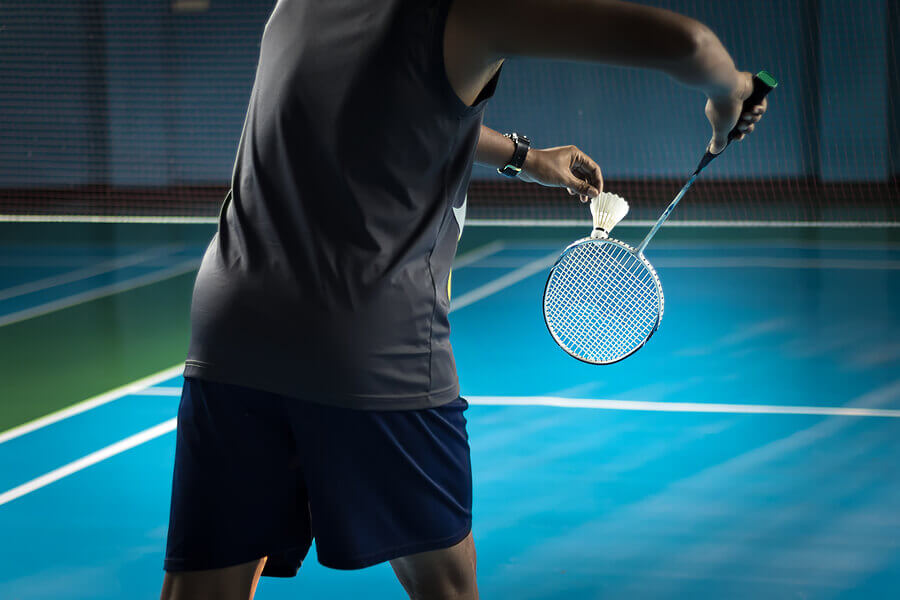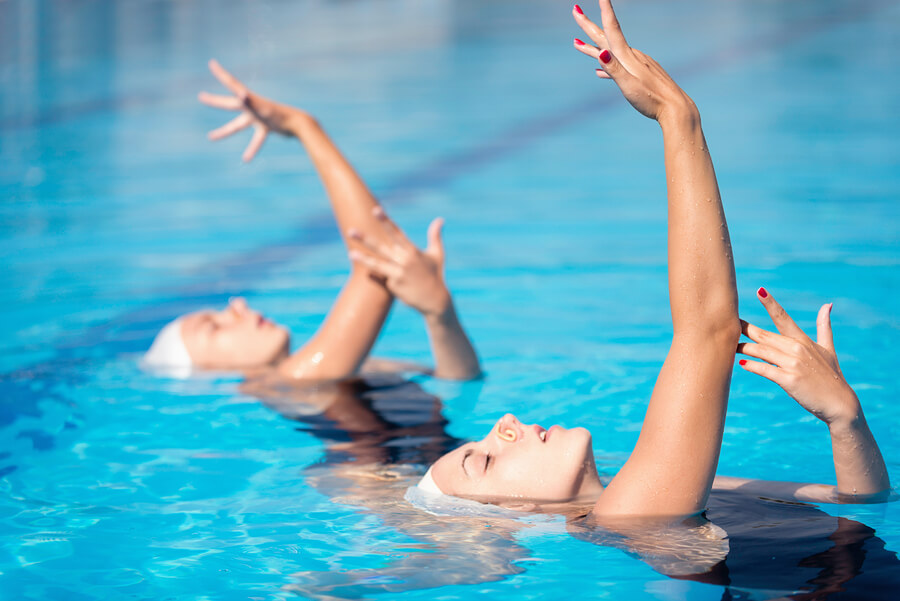8 Pair Sports in the Olympics

The events in the Olympic Games can fall under several categories: indoor and outdoor sports, ball sports and others, or how many athletes or players participate on a team. In today’s post, we want to talk about pair, or doubles sports in the Olympics.
The pair sports in the Olympics
Some pair sports are strictly doubles while others also have individual or team events as well. Some examples include:
1. Beach volleyball
Beach volleyball is the only Olympic sport that is strictly doubles. So each beach volleyball game is made up of two teams of two players. The sport joined the Olympic line-up in Atlanta 1996 and the court is usually artificial sand.
Things that differentiate beach volleyball from traditional volleyball is that the former is outdoors, doesn’t allow subs and has a smaller court. As for attire, beach volleyball players wear shorts or bathing suits, sunglasses, and hats. In addition, they play barefoot.
2. Badminton
Badminton can either be singles or doubles– traditional men’s and women’s or mixed– and the players face off on a rectangular court that’s divided by a net. Instead of a ball, badminton players use a shuttlecock, which has a cone-like shape and feathers on the end.
Badminton first entered the Olympics in the 1992 Barcelona Games. The Asian countries dominate the courts: China, Indonesia and South Korea hold 28 of the 29 nine medals disputed until today.

3. Synchronized swimming, one of the most beautiful pair sports in the Olympics
Synchronized swimming, or artistic swimming, has three events for individuals, teams, and pairs. Swimmers must coordinate their movements to their music both inside and outside the water. They also must possess strong swimming skills, physical strength, grace, and precision… not to mention being able to hold their breath!
Synchronized swimming has been in the Olympics since the 1984 Los Angeles Games. But, in the Olympics and World Championships, the sport is only female.

4. Rowing
Rowing has two modalities for sliding seat Olympic pairs: coxless pair and double sculls. In the latter event, each rower rows with an oar in both hands.
Unlike in coxless pair, in double sculls, the rowers sit in a line. As a result, double scull rowers can better combine their strengths to move faster than they could as a coxless pair.
5. Diving
Diving is another Olympic sport that can be individual or pair, or synchronized diving. Divers jump into the pool from a springboard that’s set at different heights.
During the seconds that they have in the air, the divers must impress with gymnastic moves. In the case of pair diving, both divers need to follow the same performance and hit the water at the same time.
Synchronized diving first joined the Olympics in the 2000 Sydney Games. Men’s diving, however, has been around since 1904.
6. Tennis, one of the best-known pair sports in the Olympics
Though singles tennis is usually the crowd’s favorite, doubles tennis is also an event in annual tennis competitions and the Olympic Games. Singles and doubles tennis share the same rules; the only difference, however, is that in doubles, teams play three sets instead of five.
In addition, because there are two players in doubles (instead of one player in singles), one of them usually stays nears the net while the other stays at the baseline.
7. Table tennis
Table tennis, or ping pong, has been an Olympic sport since the 1988 Seoul Games. Players can compete either as individuals or in doubles.
Many people consider it to be the most complicated game in the world because it uses a tiny court and an even smaller ball– not to mention the paddles. In addition, the game moves faster than other disciplines.
Table tennis derived from tennis. Thinking of England means that creators designed it as a sport that players could enjoy during the cold, winter months.

8. Sailing
The last pair sport on our list can also be an individual sport in the Olympics. Sailing first appeared in the 1900 Paris Games and since then, has seen many changes in classes and styles. The pair categories are 470, 49er and Nacra 17 mixed.
Wrapping up, there are many pair sports in the Olympics but they all require a strong bond between the players for the best performance. In these events, players always share both victories and failures!
The events in the Olympic Games can fall under several categories: indoor and outdoor sports, ball sports and others, or how many athletes or players participate on a team. In today’s post, we want to talk about pair, or doubles sports in the Olympics.
The pair sports in the Olympics
Some pair sports are strictly doubles while others also have individual or team events as well. Some examples include:
1. Beach volleyball
Beach volleyball is the only Olympic sport that is strictly doubles. So each beach volleyball game is made up of two teams of two players. The sport joined the Olympic line-up in Atlanta 1996 and the court is usually artificial sand.
Things that differentiate beach volleyball from traditional volleyball is that the former is outdoors, doesn’t allow subs and has a smaller court. As for attire, beach volleyball players wear shorts or bathing suits, sunglasses, and hats. In addition, they play barefoot.
2. Badminton
Badminton can either be singles or doubles– traditional men’s and women’s or mixed– and the players face off on a rectangular court that’s divided by a net. Instead of a ball, badminton players use a shuttlecock, which has a cone-like shape and feathers on the end.
Badminton first entered the Olympics in the 1992 Barcelona Games. The Asian countries dominate the courts: China, Indonesia and South Korea hold 28 of the 29 nine medals disputed until today.

3. Synchronized swimming, one of the most beautiful pair sports in the Olympics
Synchronized swimming, or artistic swimming, has three events for individuals, teams, and pairs. Swimmers must coordinate their movements to their music both inside and outside the water. They also must possess strong swimming skills, physical strength, grace, and precision… not to mention being able to hold their breath!
Synchronized swimming has been in the Olympics since the 1984 Los Angeles Games. But, in the Olympics and World Championships, the sport is only female.

4. Rowing
Rowing has two modalities for sliding seat Olympic pairs: coxless pair and double sculls. In the latter event, each rower rows with an oar in both hands.
Unlike in coxless pair, in double sculls, the rowers sit in a line. As a result, double scull rowers can better combine their strengths to move faster than they could as a coxless pair.
5. Diving
Diving is another Olympic sport that can be individual or pair, or synchronized diving. Divers jump into the pool from a springboard that’s set at different heights.
During the seconds that they have in the air, the divers must impress with gymnastic moves. In the case of pair diving, both divers need to follow the same performance and hit the water at the same time.
Synchronized diving first joined the Olympics in the 2000 Sydney Games. Men’s diving, however, has been around since 1904.
6. Tennis, one of the best-known pair sports in the Olympics
Though singles tennis is usually the crowd’s favorite, doubles tennis is also an event in annual tennis competitions and the Olympic Games. Singles and doubles tennis share the same rules; the only difference, however, is that in doubles, teams play three sets instead of five.
In addition, because there are two players in doubles (instead of one player in singles), one of them usually stays nears the net while the other stays at the baseline.
7. Table tennis
Table tennis, or ping pong, has been an Olympic sport since the 1988 Seoul Games. Players can compete either as individuals or in doubles.
Many people consider it to be the most complicated game in the world because it uses a tiny court and an even smaller ball– not to mention the paddles. In addition, the game moves faster than other disciplines.
Table tennis derived from tennis. Thinking of England means that creators designed it as a sport that players could enjoy during the cold, winter months.

8. Sailing
The last pair sport on our list can also be an individual sport in the Olympics. Sailing first appeared in the 1900 Paris Games and since then, has seen many changes in classes and styles. The pair categories are 470, 49er and Nacra 17 mixed.
Wrapping up, there are many pair sports in the Olympics but they all require a strong bond between the players for the best performance. In these events, players always share both victories and failures!
All cited sources were thoroughly reviewed by our team to ensure their quality, reliability, currency, and validity. The bibliography of this article was considered reliable and of academic or scientific accuracy.
- Davison, R. C. R., van Someren, K. A., & Jones, A. M. (2009). Physiological monitoring of the olympic athlete. Journal of Sports Sciences. https://doi.org/10.1080/02640410903045337
This text is provided for informational purposes only and does not replace consultation with a professional. If in doubt, consult your specialist.








